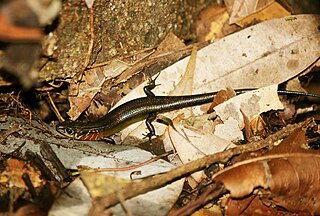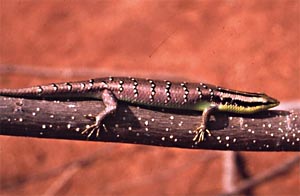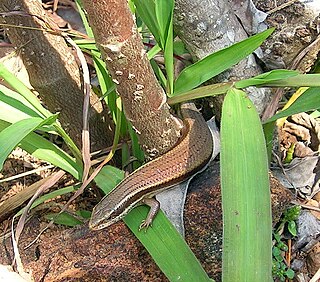
Skinks are lizards belonging to the family Scincidae, a family in the infraorder Scincomorpha. With more than 1,500 described species across 100 different taxonomic genera, the family Scincidae is one of the most diverse families of lizards. Skinks are characterized by their smaller legs in comparison to typical lizards and are found in different habitats except arctic and subarctic regions.

The Solomon Islands skink, also known as prehensile-tailed skink, monkey-tailed skink, giant skink, zebra skink, and monkey skink, is an arboreal species of skink endemic to the Solomon Islands archipelago. It is the largest known extant species of skink.

Cryptoblepharus is a genus of skinks, lizards in the family Scincidae. The genus contains at least 53 species.

Lankascincus is a genus of lizards, commonly known as lanka skinks and tree skinks, in the family Scincidae. The genus is endemic to Sri Lanka.

Lygosoma is a genus of lizards, commonly known as supple skinks or writhing skinks, which are members of the family Scincidae. Lygosoma is the type genus of the subfamily Lygosominae. The common name, writhing skinks, refers to the way these stubby-legged animals move, snake-like but more slowly and more awkwardly.

The broad-headed skink or broadhead skink is species of lizard, endemic to the southeastern United States. The broadhead skink occurs in sympatry with the five-lined skink and Southeastern five-lined skink in forest of the Southeastern United States. All three species are phenotypically similar throughout much of their development and were considered a single species prior to the mid-1930s.

George Albert Boulenger was a Belgian-British zoologist who described and gave scientific names to over 2,000 new animal species, chiefly fish, reptiles, and amphibians. Boulenger was also an active botanist during the last 30 years of his life, especially in the study of roses.

The common garden skink is a small species of lizard in the family Scincidae. The species is endemic to Australia. Additional common names for L. guichenoti include grass skink, Guichenot's grass skink, pale-flecked garden sunskink, and penny lizard.

Leo Daniel Brongersma was a Dutch zoologist, herpetologist, author, and lecturer.
The green-blooded skink, sometimes (ambiguously) known as "green tree skink", is a scincid lizard species native to New Guinea. The species is poorly studied and the species' risk of extinction has not been evaluated by the World Conservation Union, and does not appear in any CITES appendix.
Green tree skink can refer to several skink species:

Dasia is a genus of lizards, commonly known as tree skinks or dasias, in the family Scincidae. The genus is endemic to Asia.

Trachylepis is a skink genus in the subfamily Mabuyinae found mainly in Africa. Its members were formerly included in the "wastebin taxon" Mabuya, and for some time in Euprepis. As defined today, Trachylepis contains the clade of Afro-Malagasy mabuyas. The genus also contains a species from the Brazilian island of Fernando de Noronha, T. atlantica, and may occur in mainland South America with Trachylepis tschudii and Trachylepis maculata, both poorly known and enigmatic. The ancestors of T. atlantica are believed to have rafted across the Atlantic from Africa during the last 9 million years.

The sociable weaver is a species of bird in the weaver family that is endemic to southern Africa. It is the only species in the monotypic genus Philetairus. It is found in South Africa, Namibia, and Botswana. but their range is centered within the Northern Cape Province of South Africa. They build large compound community nests, a rarity among birds. These nests are perhaps the most spectacular structure built by any bird.

Scincomorpha is an infraorder and clade of lizards including skinks (Scincidae) and their close relatives. These include the living families Cordylidae, Gerrhosauridae, and Xantusiidae, as well as many extinct taxa. Other roughly equivalent terms include the suborder Scinciformata, or the superfamily Scincoidea, though different authors use these terms in a broader or more restricted usage relative to true skinks. They first appear in the fossil record about 170 million years ago, during the Jurassic period. The phylogeny below follows that of Alifanov in 2016.

Lygosominae is the largest subfamily of skinks in the family Scincidae. The subfamily can be divided into a number of genus groups. If the rarely used taxonomic rank of infrafamily is employed, the genus groups would be designated as such, but such a move would require a formal description according to the ICZN standards.

The Noronha skink is a species of skink from the island of Fernando de Noronha off northeastern Brazil. It is covered with dark and light spots on the upperparts and is usually about 7 to 10 cm in length. The tail is long and muscular, but breaks off easily. Very common throughout Fernando de Noronha, it is an opportunistic feeder, eating both insects and plant material, including nectar from the Erythrina velutina tree, as well as other material ranging from cookie crumbs to eggs of its own species. Introduced predators such as feral cats prey on it and several parasitic worms infect it.
Emerald skink may refer to:
The Kalahari tree skink or spiny mabuya is a lizard in the skink family (Scincidae). The species is endemic to southern Africa, including Namibia, South Africa, western Botswana, and southern Angola.












